When was the last time you have been pleasantly surprised by a board game? In today’s world of board game collecting, with all the great YouTubers out there doing reviews, crowdfunding campaigns hitting home their message months/years before we get a game into our hands and of course BGG, the times where you go to your friendly local game store and discover a game have become rare. There is also a clear, instagramable language of cover art, setting and component list that primes us what to expect from a game. It has become much more common to be disappointed because expectations – regardless of being justified or not – where not met.
So imagine yourself in your friendly local game store. You’re just browsing for what’s new and see three games: a nice looking medieval city builder, a brawler with cool minis and a bubbly-cheerful looking game about cell growth. Which one do you pick? Honestly, I’d probably go with option one in about 95% of the times. Would you pick option three? With all the games you already own and getting new games to the table being more and more difficult? I’d imagine myself pitching my new purchase to my group and saying “ok, let’s not play the brand new Ark Nova, let’s skip continuing our campaign of Gloomhaven, let’s go with THIS”. Well, here is to why you and me should have indeed considered picking the odd one out.
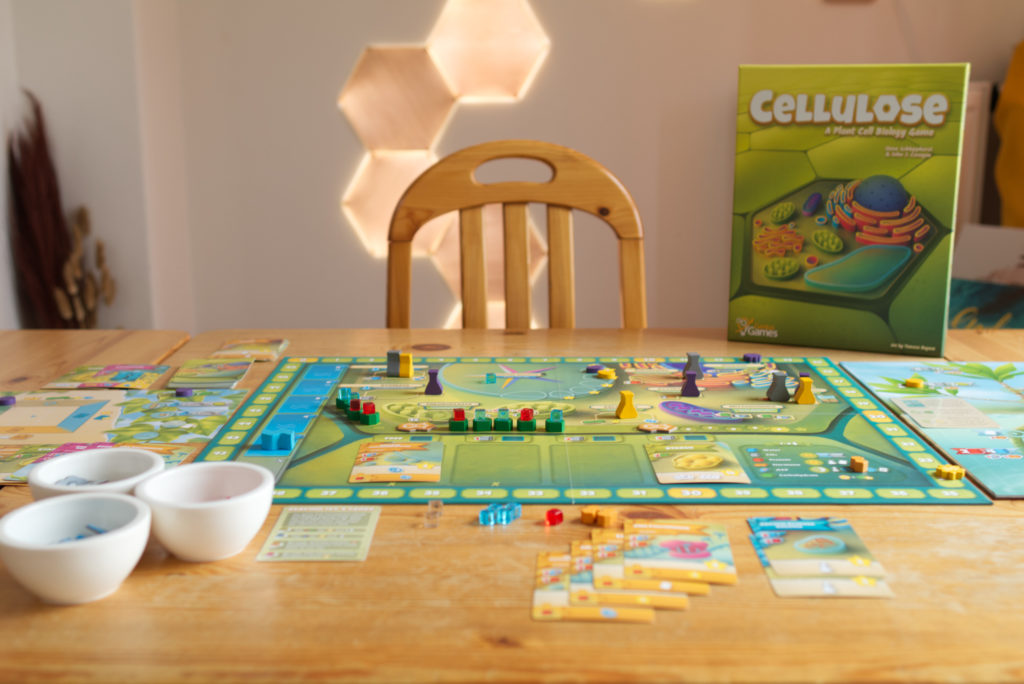
Setup
At its core, Cellulose is a worker placement game. So to make things simpler to explain, let’s postpone talking about theme for now, deal with it in the abstract and come back to the theme later. Setup is quick: pick the side of the main board that corresponds to the number of players, 1-3 on one side, 4-5 on the other. Both sides feature the exact same functionality, the main difference is how many players can use a spot in the same round. You’ll see various elements that are important for the inner workings of a cell. Shuffle the deck of cards and place one in each spot of the market in the bottom area of the board. On the left, there is a track to indicate the current level of available water on to which a chunky blue wooden token is placed as the marker. Setup the side board showing a plant next to the main board and place two disks for each player on this board. This represents the roots and shoots of a plant that you can grow and shows what income you get at the beginning of the round. Give each player the three action markers (=workers) in the shape of those bottles you might now from your chemistry class, place their VP marker (a flower) on the VP track and decide on a starting player. That’s it. It’s quite fast and you are left with an initial feeling of “that’s all I get”? You don’t even get an initial hand of cards because using those cards is just one of multiple different ways to win the game and you might end up never ever even purchasing a single one. But I’m getting ahead of myself.
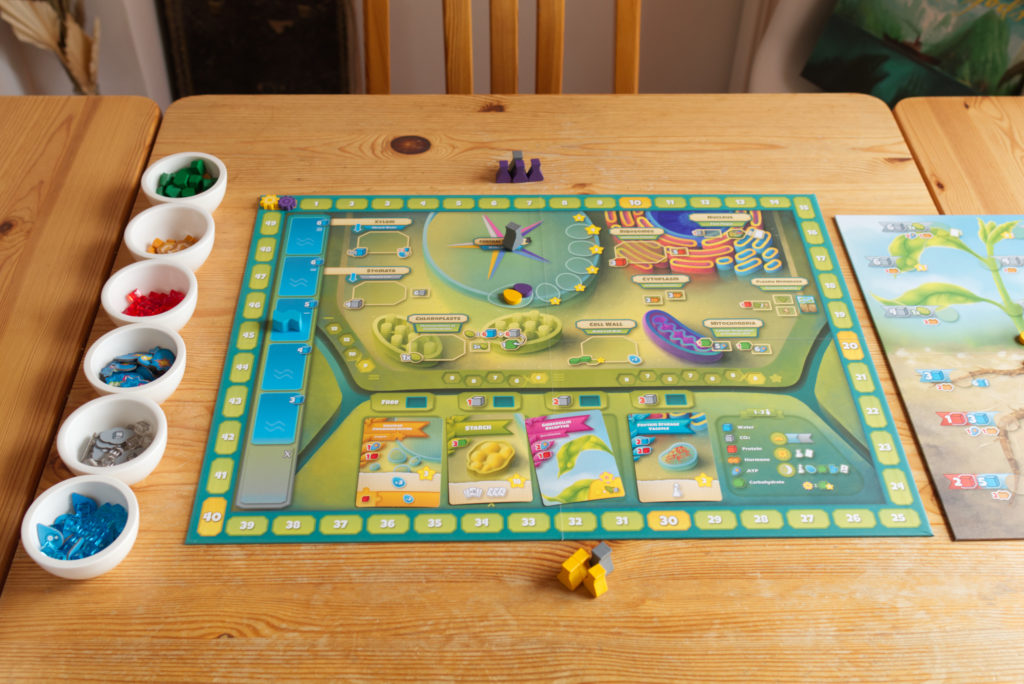
The Turn
There are three phases in each turn: Sunrise where all players get their income, daytime where players go round placing their action markers, and evening where a number of clean up steps and preparation for the next round happens. When it’s your turn, pick one of your action markers and place it on any available action spot, and perform the printed action. After that you can optionally play one of your cards – if you have any – by paying the cost printed on the card, put it in front of you and gain the respective benefits. That’s it, next player. Play continues until all players have placed all their action markers, while some might have more than others.
There are two types of action spots: small ones that just fit a single action marker and larger ones. On the latter, multiple players can place their action markers and sometimes even the same player can place multiple there. The main rule is: only one marker of each color is allowed on a large action spot. You might be wondering if that is not the same as one-per-player. At the end of a round, you and another player will have the chance to acquire an additional grey action marker at the end of the round as we will see later. So one can place a marker of his/her color and a grey marker (if they own one) on the same action, but not two player can both place a grey marker on the same spot.
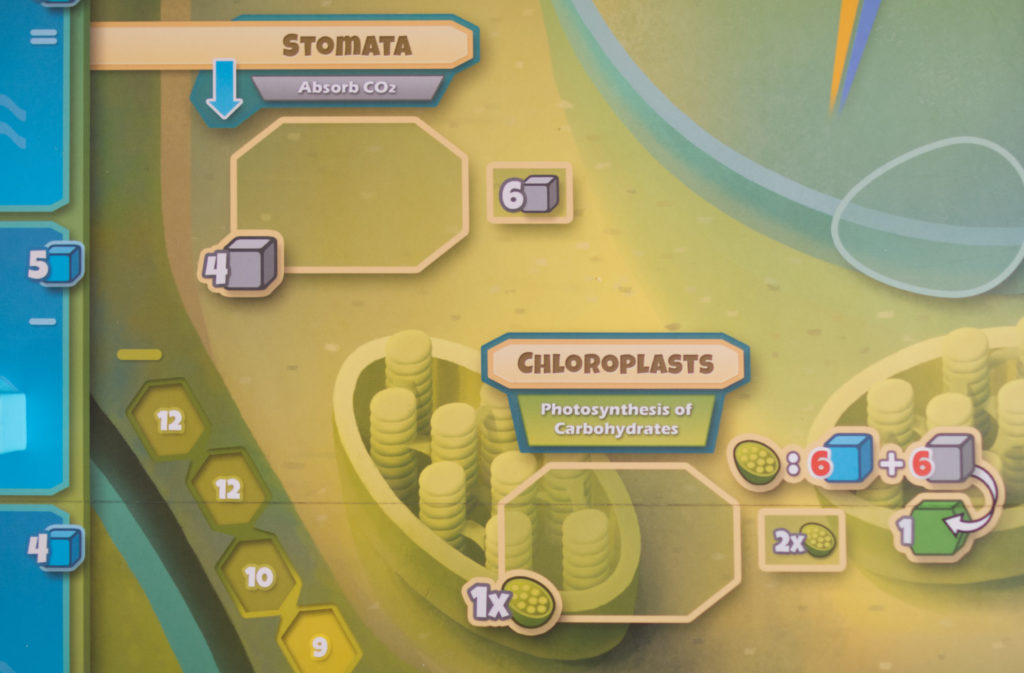
In general, small spots are more desirable as they will give you more resources of the same type as the corresponding larger action spot. I won’t go through all possible actions, so let me just say they are all very simple, most amount to taking a certain resource or converting them into another resource. There are however four areas of the board that are special:
1. Water/Co2: these are the two most fundamental resources. If you use one of the actions to acquire those, the water level indicator will go down, decreasing the amount of water players can get with further actions. This even goes as far as no player being able to use the water action if the marker has already hit rock bottom.
2. The central water area (it’s called Central Vacuole, but you and I will probably have forgotten that name before we reach the next section, so let’s call it the central water area): Certain actions and benefits allow you to put water in this area. At the end of the round (=evening), the player(s) that placed the most water here will not only get some VP but also one of those coveted grey action markers, giving you an extra action for the next round. The battle here can get fierce and I’ve seen amounts of 7-10 water per player multiple times. The problem is: most of the water you put there is water that you would have needed to do other stuff. So it’s always a question of whether or not it is worth for you to participate. The fun bit: if you don’t win the round, your water stays in there but the winner’s is removed. In the other extreme, you can sometimes win this with a single water if you time it correctly and block your opponents from all possibility to add further water this round.
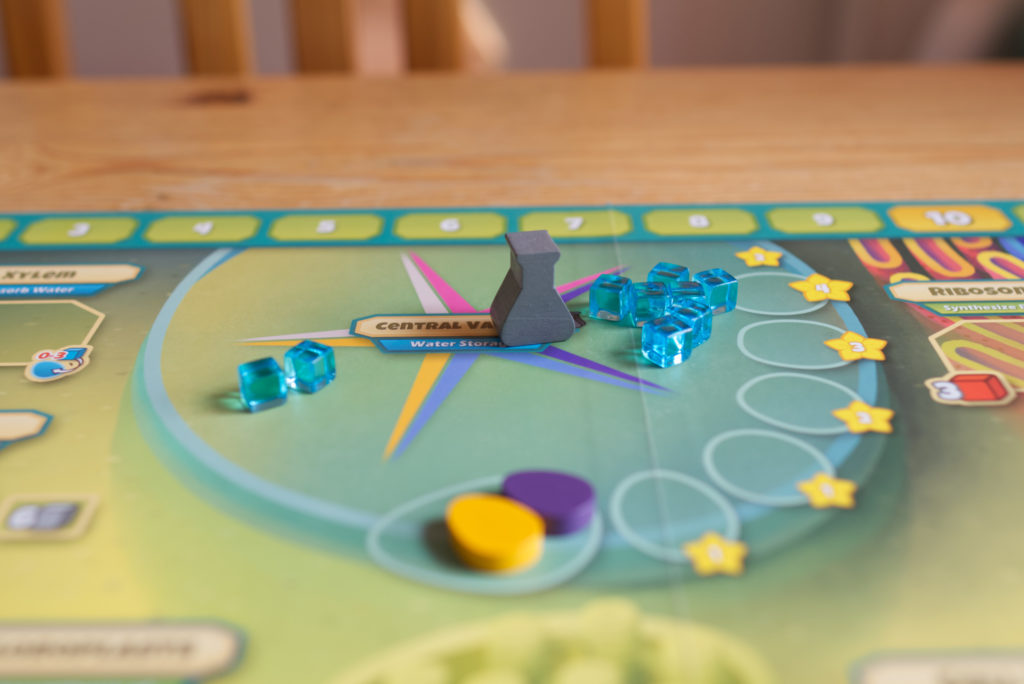
3. Growth: growth allows you to move your discs on the plant side board. The top part (shoots/leafs) is for increasing your CO2 income, the bottom part (roots) for increasing your water income. When you do a growth action, you can move your discs along the roots/shoot graphics to the next level which allows you to pick one of multiple compromises: do you want to have more water or rather water and protein? Or more victory points?
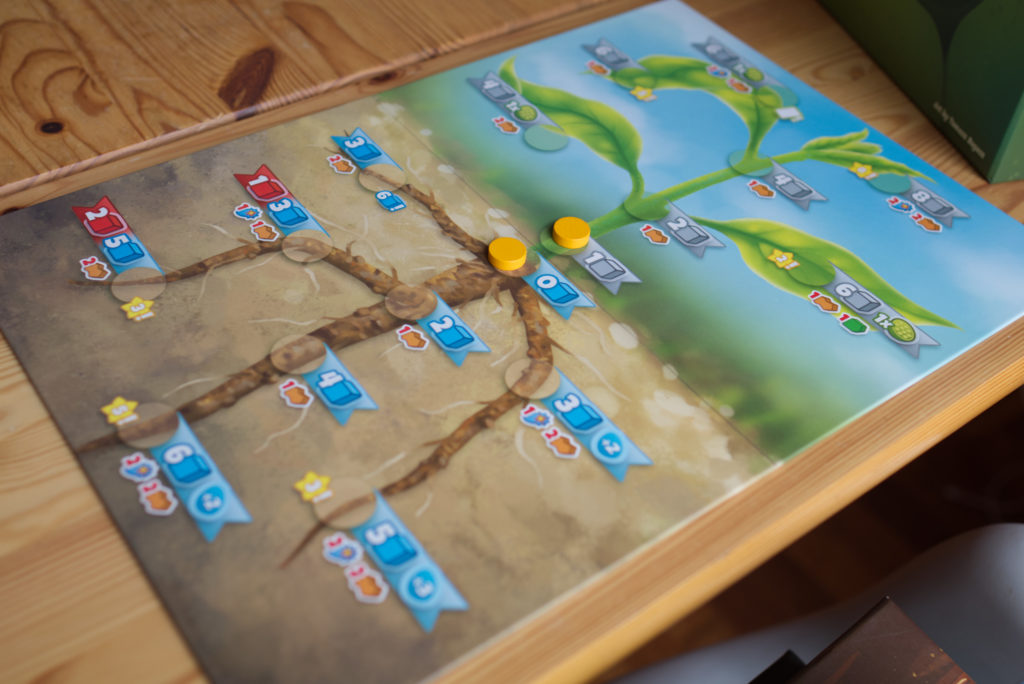
4. Card market: to get a card, you have to place one of your action markers here. The market is only refilled at the end of the round, so first come first served. Each card is in one of four categories: blue allows you to take back your action marker and have another action, pink are for end game points, orange can be chained and activated when you play another orange, and green allows you to convert your green markers to VP as an alternative to building the cell wall. Don’t expect too much variety. Within one category, the cards do pretty much the same with varying costs/rewards, enzymes being the big exception. Enzymes are fun because you can – at a cost – activate all enzymes you already have if you play an additional one, giving you their bonus again and again.
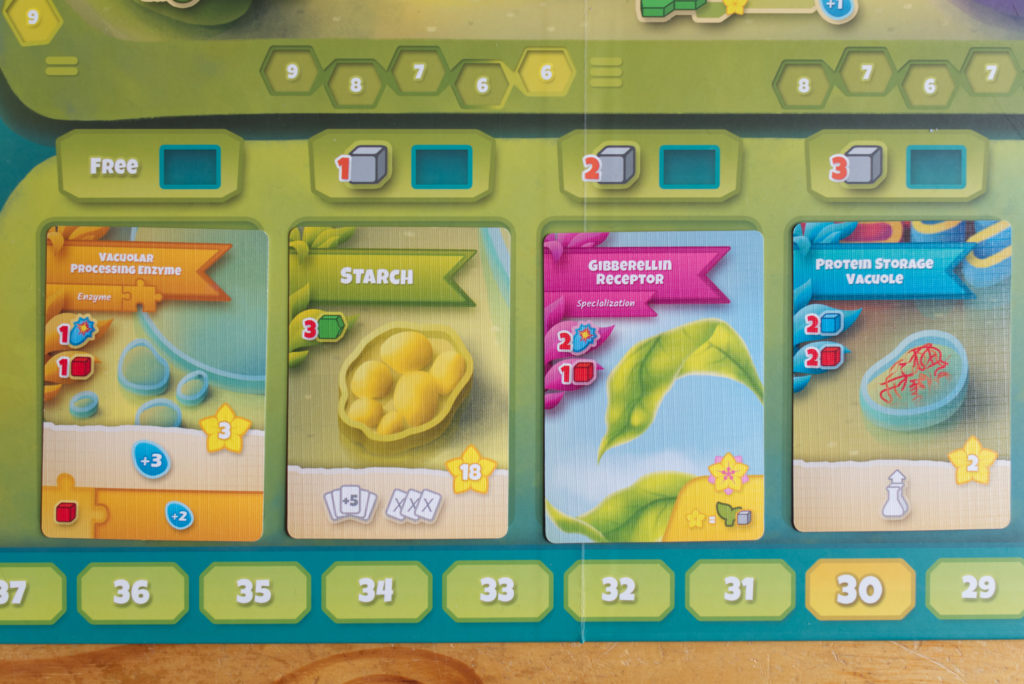
End of Game
Speaking of which, the main way of generating victory points (called health points) is by gathering water and CO2, convert them to Carbohydrates via photosynthesis and then add them to the cell wall. You always have to build on the next available slot and VP – for the most part – decrease the later in the game you build. There are two gaps in the wall. Once the wall reaches such a gap, the next phase of the game starts: We start in phase 1, in phase 2 and 3 the water level rises (the water marker starts on a higher level) and once the wall is complete that’s it. Check if you get any additional VP from pink cards you played, excess green tokens are worth 4 VP. Total scores I’ve seen so far are around 70-100 VP.
Preparing for the Next Round
I’ve jumped over or only hinted at what happens at then end of a round as it made things easier to grasp. Let’s go into more detail now: players take back their action markers, the water majority area (can you remember its correct name? If not, don’t worry. You’re in good company) is evaluated and the players that have the most water will take a step up on it’s track, gain VP and if there is only one player with the most (two in a 4+ player game), that player(s) will get an extra grey action marker for the next round. Then a green token is placed in the wall (so the game will progress regardless of whether or not players actually build on the cell wall), some stale cards are removed from the card market and refilled. Finally, the water marker is moved up again. On to which water level it is placed depends on the phase the game is in as indicated by the cell wall. Towards the end, more water is thus made available for the taking.
Scenarios
As always, I gloss over large parts to rather give you the feel of the game. There are however two included alternative scenarios that are worth mentioning: the mangrove and the cactus scenario. Cactus reduces the amount of available water and makes it harder to grow roots, mangrove reduces the game to 2 phases but the automatic wall building at the end of the round no longer happens. In addition, the reverse of the plant board is used which allows for different growth/income strategies.
I tested both of them and really liked them. They feel highly appropriate for the theme and change the formula in interesting ways. However, I recommend first playing the standard game 2-3 times, not because the scenarios are complicated but because the standard game gives you a nice priming of what is “normal” and then makes it even more an experience when you suddenly have problems getting water/roots for example. They work mainly in contrast to the standard game but on the other hand are not too far out there. They still feel very much like Cellulose.
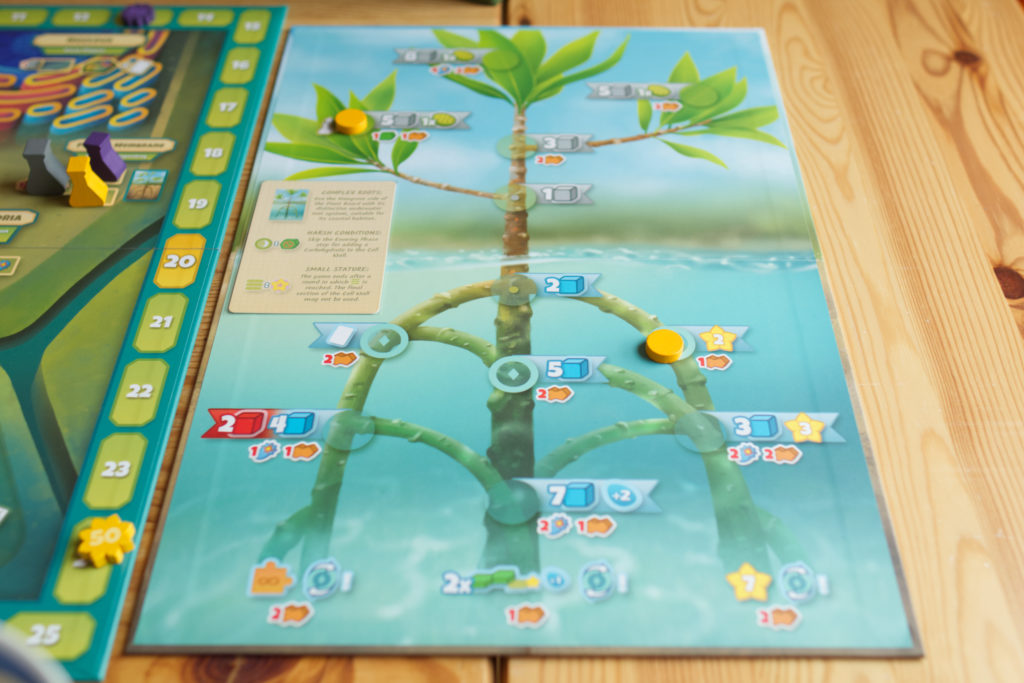
In the standard game, certain action spots may feel odd to heavy gamers: in most games I’ve played, doing growth happens early in the game as we are all trained that early income is good and will pay off over the whole game. But with the standard plant board, you quickly reach the end of the roots/shoots path you have chosen. After that, you cannot take the growth action anymore and therefore also have no need to get the orange tokens you need for growing. I’m still not 100% sure about this. However, the early wall spots produce much higher points than the later ones (12 vs 8-6) so it does seem viable to skip on growth for the most part and instead go for an early point grab. That might feel odd to a number of players as that prototypical game arc is so engrained in us: early game boost income, mid/late game convert to VP. I actually find it refreshing to hit the growth-wall and be forced to think differently.
In later games, I much more tried to do early wall building and delay growth a bit. If 1-2 players go heavy on cell wall building, the game can be over before growth income really pays off. The two scenarios actually highlight this quite nicely. Due to their constraints, I started to play differently and may take aspects of that back to the standard game.
Solo Mode
Okay, this one is a treat. So far I’ve played 8 times in total (hence the “first impressions” instead of a full review) and only one time with two players. The rest was solo and highly enjoyable. Enjoyable is even the wrong word, I would put it more as addictive. Case in point: in the exact same delivery as Cellulose, my copy of Praga Caput Regnicame. I had been wanting to give this a try for months and months as I like both Underwater Cities and Messina 1347 (see First Impressions of Messina 1347 – A Special Act of Balance). However, Cellulose got the better of me and I had played 6 games of Cellulose before I finally cracked open Praga.
In solo mode, you play against an automa called “Ivy”, a name I really like for an automa. Ivy has a priority-option-deck (i.e. draw card, check if first option is possible, if not check second option) with added conditions printed on the cards (e.g. only build cell wall if it would earn at least 8VP). Administrating Ivy is therefore quick to do. The important bit is that one has to remember to a) place Ivy’s action marker on the respective spot and b) make sure she can actually do the action (does she have the required resources, not already an action marker on the spot). It’s simple, however a bit error prone at first. Actions are so quick that you can easily forgot if it is your’s or Ivy’s turn. Or you might end up doing the action (such as give her water) without placing her action marker or lowering the water level as a result. It took me 3-4 games until I didn’t mess up and still I have situations where I’m not 100% sure if I did EVERYTHING and not just the major part of her action. Despite the mistakes I made, I always had fun and a good challenge, so it’s not much of a problem.
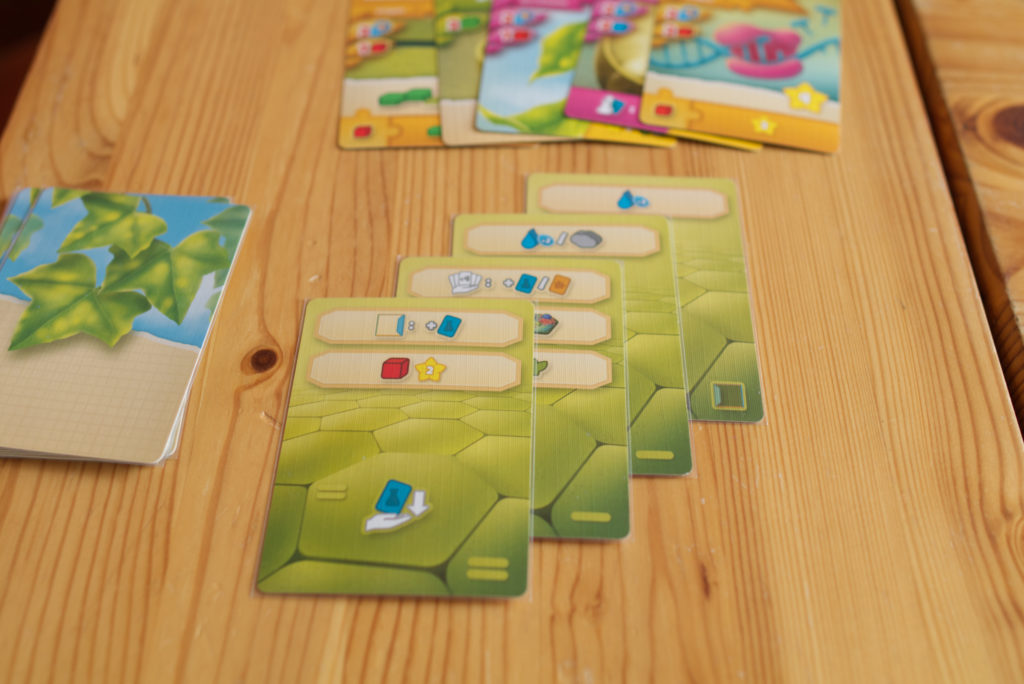
Similar case in point: when the game reaches phase 2, a set of additional cards are placed in her discard pile. I forgot to do this a number of times and got into the habit of placing one of the orange enzyme 5-er tokens on the cell wall as a reminder. Works like a charm now.
One interesting bit is Ivy’s strategy map, a separate side board (=thick paper, not cardboard) only used during solo play. For the most part, Ivy plays the same game as you. A few things are simplified, so she doesn’t use resources except for water/co2/green wall tokens. However, she doesn’t place her discs on the plant board but instead has her own growth progression (she’s an ivy after all). Whenever she does growth, she climbs up her own growth track unlocking various income for the following rounds. The main part of the side board is the strategy area: at the start, Ivy places a disc in the center of a 5×5 grid. When Ivy does certain things due to the automa cards, the disc moves in one of four directions. Each direction represents a strategy a human player could also take: focus on water, focus on growth, focus on enzyme chaining or focus on blue cards (to have more actions). The disc needs to be moved when the corresponding actions happen (e.g. when she gets an orange card, move the disc down toward the enzyme strategy) and she locks into a strategy once the bottom/top/left/right row or column is reached. If she does so, she gets another special card for her automa deck that corresponds to that strategy and won’t move in the opposite direction. However, she will still move in the orthogonal direction. So at game end, she typically ends up in one of the corners.
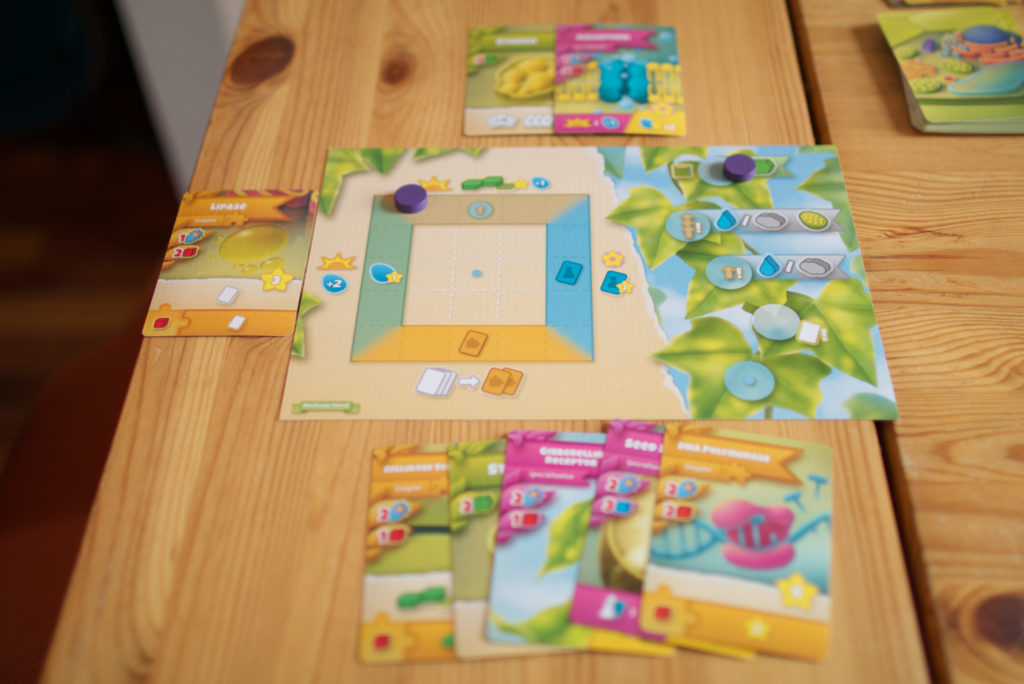
The automa side board has two sides, one for easy and the other for medium/hard. I’ve only played medium so far and have only beaten her two times. I quite like this map. It manifests “intent” which always helps to give an automa life. However, it is easy to forget to update it and the effect of the added specialized cards seem to be minor overall. Once she locks in on a strategy, she also gets a bonus for it (e.g. two automatic water in the central water area at the beginning of each round). I haven’t really made notes of how often the specialization cards come up, but for me personally, having the bonus and the marker that moves already does the trick. Ivy feels reasonably similar to a human player and when she again goes for a water strategy, I sigh and think “not again”, knowing I will have a hard time getting that extra grey action marker. Compared to a human player, she seems to have an easier time getting enough water to both compete in the central area as well as to convert to green cell wall tokens. However, she also sometimes makes tactical blunders in the late game, adding to the central water area when she already dominates there instead of snatching up the last few available cell wall spots. In the vast majority of my solo games, she ended up following a water/growth strategy, even if I tried to actively block her from it. So don’t expect an equal distribution of what strategy she will take. Still fun though.
All in all, I really like her and I think it’s a big plus point of Cellulose that she is part of the package. I can gives Cellulose a recommendation even if you are only ever going to play this solo.
Conclusion
I’ve been debating for a while what title I should give this first impressions. There are so many aspects of Cellulose that are different from other games and on which I could have focused. And I haven’t even talked about the theme yet! Don’t worry, I will. I ended up with “box of delights” because Cellulose reminds me of a box of chocolate. It is not an outstanding game in the sense that I don’t see it hitting the BGG hotness and most YouTuber’s will probably gloss over it. After all, they have to talk about what people are looking for to get new subscribers. Showing of a game they like can at best give them a couple of views and at worst a penalty from the almighty algorithm. Luckily, I don’t have that problem and can just write about whatever game gets me really curious.
As I said in the beginning, I wasn’t prepared for how much I would like Cellulose. As a solo game, it hits a sweet spot because it is chunky enough to not feel trivial but light enough to be pulled out whenever I’m in the mood for a fun 45-60 minutes. The one 2 player game I had was similar enjoyable and proofed a point: if I would have let my friend choose a game, he probably would have picked something else. The competition is quite fierce and I’ve been on a spending spree lately, I have to admit. So the fact that I wanted to play this repeatedly to get a feel for Ivy and try out the two scenarios says a lot when the competition would have been Praga Caput Regni, Dune: Imperium – Rise of Ix, Kanban EV, Sleeping Gods to name just a few.
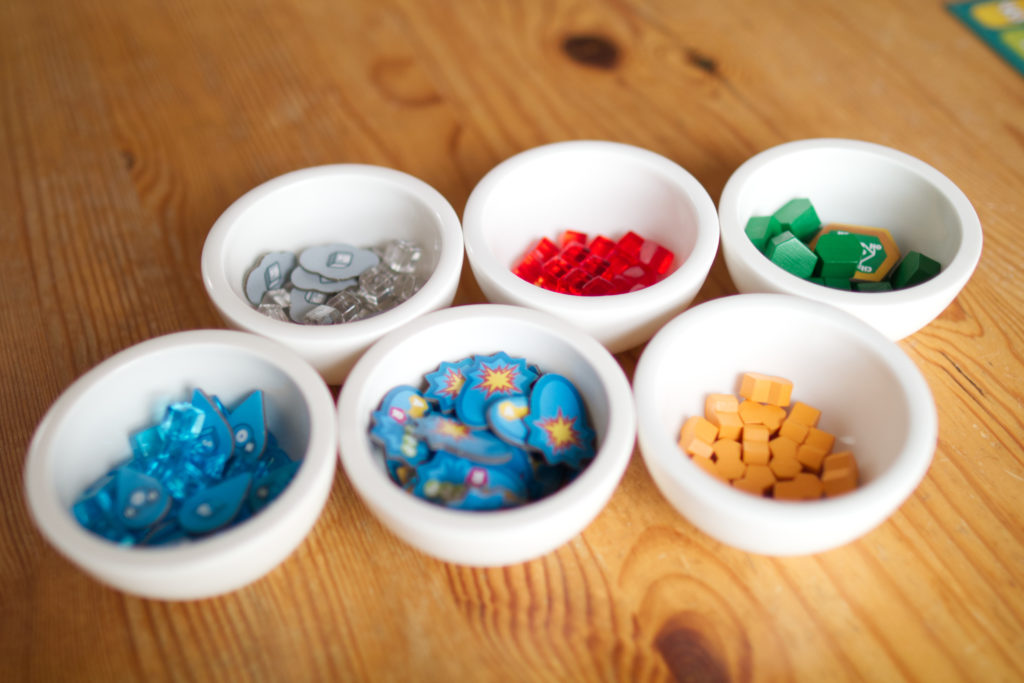
I wanted to see how my friend’s reaction would be so that’s why I pitched Cellulose instead of letting him choose. The result: he had fun, at the end commented on how delightful that was, and that he liked the different setting. We had some fierce competition on the central water area, different paths we took on the growth board, and overall all nice “why did you have to take that away” moments. Still it was light enough so we could play it after a long week of work. Similarly, I cannot really see anyone in my groups not liking this. For casual gamers it’s really simple to grasp and for heavy euro-players it’s easy to see where they can be a cutthroat. I cannot say anything about larger play groups yet but I would imagine the overall playing experience to be rather similar.
Right now, I’m still in discovery/evaluation mode. I evolved my initial strategies a bit and moved from early income more to early cell wall building. I really like the chaining of enzymes but start to go more for blue cards to get more actions. The pink end-of-game cards I’m mostly ignoring since the cost of acquiring the necessary ATP seems to be a bit too high. But the more I play, the more I see that that calculation highly depends on the still available cell wall spots and if I want to speed up the game or keep it get going for longer by NOT building on the cell wall. The big daddy of that are the green starch cards. They let you burn 2-3 green tokens at a time for 6 VP each without costing you an action AND also allow you to cycle hand cards.
The main downside of Cellulose is closely related to its major upside: you can get lost in the flow. Since turns are so quick that you might call them micro-turns, it’s easy to overlook things. For example, both my opponent and I were so engaged in the tactical situation that we completely forgot to take income in one round and ran the risk of doing so again later on. I mean, when did you have so much fun playing a game that you were in danger of messing up the rules in major ways? There is a lot to be careful about: if you take water, you cannot place more than three into the central area. If you take water or CO2, you have to remember to lower the water level. If the game is in phase 2, you have to remember to start the water marker at a higher level, etc. It’s not that the rules are difficult, it’s that you can easily get lost in the game play. If your group is about having fun, that’s no problem, but if people get angry because you won due to an oversight three rounds ago, this will be tricky.
Production itself is very good with quality components, rules well written. I do wonder about the mixture of plastic cubes, wooden tokens and cardboard tokens for resources though. The collector’s edition that was available on kickstarter has wooden tokens for water/CO2 but metal for ATP (another, high-value resource I haven’t even mentioned yet), which also seems odd. I do have to admit thought that I already checked the BGG market place to see if I can replace my copy with a deluxe version for a decent price. ATP feels so valuable to me in game, would be nice to have something substantial as a replacement. Anyway, being serious again, I can say I have gotten used to the mix and don’t really feel either way now. It sort of makes sense: plastic transparent cubes for frequent resources, cardboard tokens for 5er and wooden token for more rare resources. Still somewhat odd. My guess is that was done deliberatly to keep production costs and therefore the end consumer price down.
One piece that needs highlighting and is a good example of the attention to detail the publisher brings is the VP marker: they are the only screen-printed wooden piece in the whole game. When we reached the end of the score board, my friend was wondering how we would mark a lap on the score track. I just flipped the wooden piece over and on the back of the flower was a printed “50” that made him comment out how neat that is. It’s the little things that put a smile on your face:
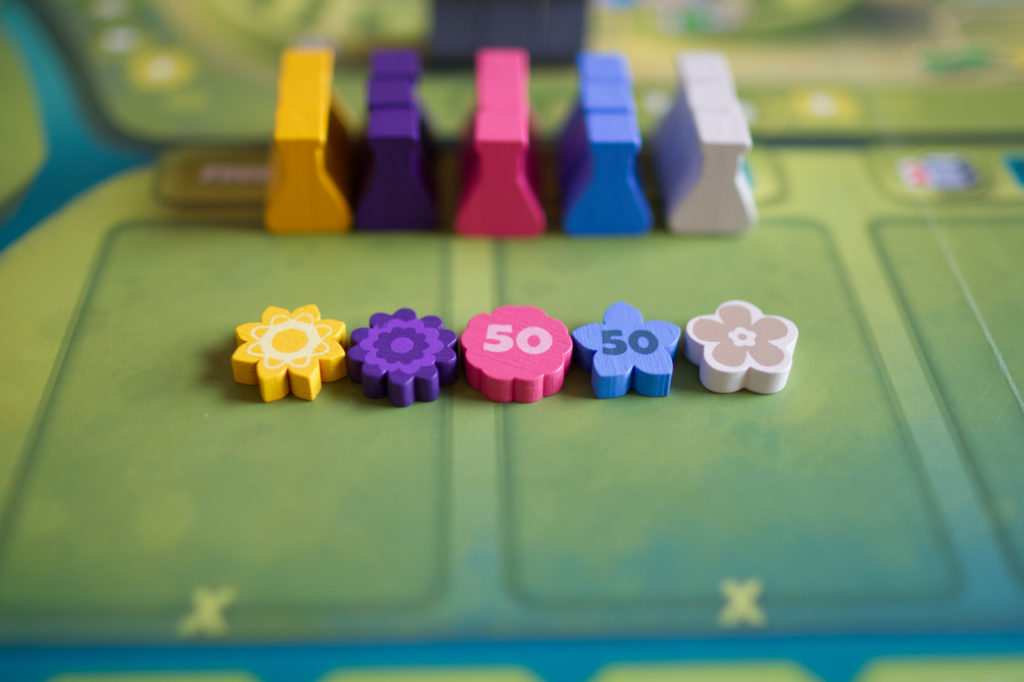
I also wished there would have been more scenarios in there. Don’t get me wrong, the standard and mangrove mode would already have been more than enough to keep you happy for a long time. But the idea of using highly thematic scenarios to mess up the normality is great. I really do hope the game succeeds and the publisher will offer more scenarios in the future. Will probably be a pain to playtest/balance though…
I’ve still got tons of thoughts about the game, which is always a good sign. But let’s finish this up by talking about the theme. I (as well as my opponent) liked the setting. It’s different, it’s fun, growing a plant and being rewarded for making it healthy is a neat idea. Note though that I called it a setting. I was wondering what the role of a theme in the context of board games is. To motivate you? To help you understand what is going on? To shape expectations?
With Cellulose, the authors try to do something that is actually quite hard: use a setting that you and I – let’s be honest – know very little about. In a city builder game, if the rules tell you to do xyz at the market place, your eye can browse the board and find it. If the rules tell you about the Central Vacuole, you have to search the board and read every text label because we don’t have a clue what it is talking about. The game comes with an extra booklet and tries to explain the chemistry happening in a cell and contrasts it with how that is reflected in the game. It is nicely done, but still – as a layperson – I find myself struggling to keep up with the vocabulary. Same in the game: my brain thinks “take a green token”, I’d have to check the reference on the board to tell my opponent to take a Carbohydrate and he/she would have to check for the reference to translate it back to “a ha, a green token”. Similarly, this is probably the only game I own where I couldn’t tell you who the players represent in the game. We’re all in competition for the resources, so it must be the same plant, but … My recommendation would therefore be: treat Cellulose more as an abstract with a nice settings. Play it, enjoy it, and if you are curious to learn something, check out the reference book that is included. I really do enjoy the setting though, the growth paths, the themed scenarios. This is where Cellulose shines. Don’t feel guilty if you skip the terminology.
To sum up, I like the breezy micro turns, getting 4 water here, converting it to a green token there, being able to easily read the board and block my opponent from getting this round’s central water bonus. The number of different resources and somewhat limited use of some of them which might be a disappointment for some actually make it easier to assess what an opponent can and cannot do. It’s a very solid worker placement game with a surprisingly large number of neat aspects: the water majority, draining the water level, blocking action spots, different card strategies, enzyme chaining, using blue cards to delay your action and change the water majority when all other players are already out. Don’t expect the most revolutionary stand out game of 2022 or the biggest brain burner. It’s the combination of lots of neat things, like that box of chocolate you like to devour from time to time. I think Cellulose has a deserved spot in a collection both for casual gamers that want something meatier than Wingspan or heavy gamers that want something more relaxed than Troyes or Agricola. I would foresee my immediate Cellulose solo addiction to subside after a few more plays but can honestly see it getting to table regularly after that, just mixed with the rest of my collection.
Disclaimer: the copy of Cellulose was kindly provided by Steve Schlepphorst , one of the two authors of Cellulose. However, I was not paid for this first impressions and it reflects my personal opinion and experience of the game. If I wouldn’t have liked the game, I simply wouldn’t have posted this … or more likely written a very lengthy article on why it’s not working for me
